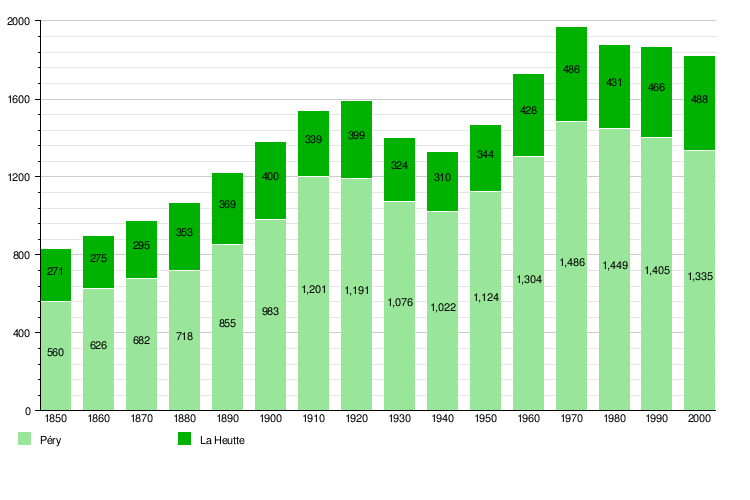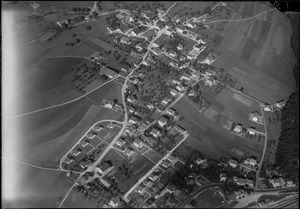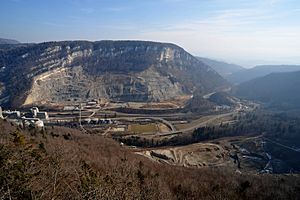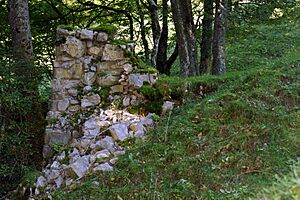Péry-La Heutte facts for kids
Quick facts for kids
Péry-La Heutte
|
||
|---|---|---|

Rondchâtel village in Péry municipality
|
||
|
||
| Country | Switzerland | |
| Canton | Bern | |
| District | Jura bernois | |
| Area | ||
| • Total | 23.78 km2 (9.18 sq mi) | |
| Elevation | 635 m (2,083 ft) | |
| Population
(Dec 2020 )
|
||
| • Total | 1,908 | |
| • Density | 80.24/km2 (207.81/sq mi) | |
| Postal code |
2603/2604
|
|
| Surrounded by | Orvin, Vauffelin, Plagne, Romont, Sorvilier, Bévilard, Malleray, Reconvilier | |
Péry-La Heutte is a town in Switzerland. It is located in the Bern canton, which is a French-speaking area. On January 1, 2015, two smaller towns, Péry and La Heutte, joined together. They formed this new municipality called Péry-La Heutte.
Contents
History of Péry-La Heutte
Early History of Péry
Péry was first mentioned in the year 884. Back then, it was called villam Bedericam. Later, in 1148, it was known as Peril. The town also had a German name, Büderich, but it is no longer used.
In 884, a ruler named Charles the Fat gave Péry to a monastery called Moutier-Grandval Abbey. The Abbey owned the village until 999. Then, the Prince-Bishop of Basel took control of it. He made Péry part of the seigniory (a lord's territory) of Erguel. The village was then given to the Lords of Péry. They ruled from Châtillon Castle, which is now a ruin on a nearby hill.
Starting in the 1300s, soldiers from Péry joined the Erguel army. This army was led by the city of Biel. In 1530, Biel encouraged Péry to accept the Protestant Reformation. This was a big change in religious beliefs.
Rondchâtel Village History
The village of Rondchâtel was separate from Péry until 1766. It is believed that a castle once stood on its hill. However, not much is known about it. In the mid-1300s, the Prince-Bishop of Basel, Johann II von Munsingen, gave Rondchâtel to his brother Conrad. Conrad was a bailiff (an official) for Biel.
From the late 1300s, Rondchâtel was owned by the de Nans and d'Orsans families. These families were from Franche-Comté. They owned the village until 1766. At that time, the last family member died. The village then went back to the Prince-Bishop. He then leased Rondchâtel to the community of Péry.
Péry's Place in France and Switzerland
After the French won a war in 1797, Péry became part of a French region called Mont-Terrible. A few years later, it became part of another French region, Haut-Rhin. After Napoleon was defeated, leaders met at the Congress of Vienna. In 1815, Péry was given to the Canton of Bern in Switzerland.
Churches and Industry in Péry
The village church of St. James was first mentioned in 884. After the village became Protestant in 1530, it became a Reformed church. The church building you see today was built in 1706. It was built around an older, Gothic building. It became the main church for the area of Péry. From 1798 to 1840, the nearby village of Vauffelin was also part of this church's area. A Roman Catholic chapel was built in Péry in 1906.
In 1654, a Prince-Bishop named Johann Franz von Schönau-Zell had a special furnace built at La Reuchenette. This furnace was used to make iron. In 1693, he gave the furnace to the Chemilleret family. They owned it until 1756. By 1782, the site had an ironworks, a house, and an inn. After the French invasion, it was taken by the government. The Société des forges d'Undervelier ran the site until it closed in 1867.
The Biel-Les Convers railway opened in 1874. This train line helped the area grow with more factories and people. A lime and cement factory opened in Rondchâtel in 1874. A wood pulp plant opened in Biberist in 1882. A branch of the Rondchâtel cement factory also opened in La Reuchenette. These businesses helped the town become richer.
A watch company from Biel, Dreyfus Frères SA, opened a branch in Péry in 1903. This company was called Péry Watch. It did not survive the financial problems of the 1930s. In 1934, the building was changed into a factory. It made typewriter ribbons, stencils, and carbon paper. This company, Carfa SA, operated until 2003. In 2005, more than half of all jobs in Péry were in manufacturing.
History of La Heutte
La Heutte was first mentioned in 1393 as Hütte. It was first called by its current name, La Heutte, in 1727.
A "glass-hut" or glass factory was mentioned in the area in 1370. It was part of the d'Orsans family's land. While a village was not mentioned then, by 1393, a village had grown around the glass factory. It was part of the seigniory of Erguel. This area was part of the Diocese of Basel (a church district). La Heutte became Protestant in 1530. This happened when Biel changed the entire Péry church area to the new faith. In the 1700s, Biel tried to gain more power. This led to many arguments with nearby villages, including La Heutte.
The first glass factory, located north of the village, was built before 1370. Another glass factory opened in the valley in the late 1400s. It stayed open until the early 1600s. Between 1650 and 1750, the village grew towards the Suze river. This was because the population increased. A successful pottery industry and a large mill developed along the river.
The first school was built in 1839. In 1876, a train station was built in the village. This helped the watch industry grow. Two years later, the Ammann watch factory opened in an old mill. In 1895, the Urania Watch Company took over from Ammann. It was then replaced by the Weber wire factory in 1938. From 1950 to 1974, many small watch workshops opened in the village. In 1985, the A16 motorway connected La Heutte to Biel. This made the village a "bedroom community", where people live but travel to work elsewhere.
In 1995, about a dozen tracks of three-toed dinosaurs were found in the area!
Geography
The towns that now make up Péry-La Heutte have a total area of about 23.79 square kilometers.
Population
The total population of Péry-La Heutte is around 1,844 people (as of December 2013).
Historic Population Trends
The chart below shows how the population of Péry and La Heutte changed over time:

Important Heritage Sites
The Le Van, which was a medieval glass factory, is a very important historical site in Switzerland. It is listed as a heritage site of national significance. The entire Taubenloch canyon is also a special protected area. It is part of the Inventory of Swiss Heritage Sites.
Transportation
Péry-La Heutte has two train stations. They are called Reuchenette-Péry and La Heutte. Both stations are on the train line that goes from Biel/Bienne to La Chaux-de-Fonds. Trains run every hour to Biel/Bienne, Moutier, and La Chaux-de-Fonds.
See also
 In Spanish: Péry-La Heutte para niños
In Spanish: Péry-La Heutte para niños








